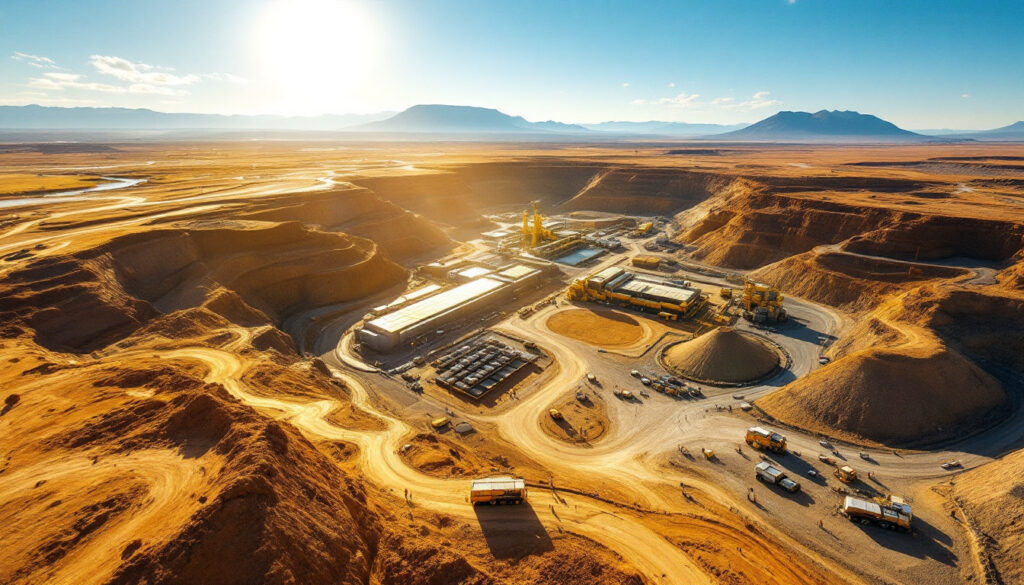B2Gold's Job Cuts at Otjikoto Mine: Impact and Future Operations
B2Gold's Otjikoto Mine in Namibia is undergoing a significant transition as the company prepares to cut 300 jobs by 2025. This strategic workforce reduction comes as the mine's open-pit operations approach their natural conclusion, marking a pivotal moment for both the company and the local economy. The downscaling represents a carefully planned transition from open-pit to underground mining operations, with long-term implications for production capacity, employment, and regional economic contribution.
Why Is B2Gold Cutting 300 Jobs at the Otjikoto Mine?
Depletion of Open-Pit Reserves
The primary driver behind B2Gold's workforce reduction is the inevitable depletion of economically viable open-pit mineral reserves at the Otjikoto site. After nearly a decade of productive operations, geological assessments indicate that surface extraction will no longer be sustainable beyond 2025. This natural conclusion to the open-pit phase has necessitated a comprehensive restructuring of operations and workforce requirements.
The transition is being implemented through a carefully phased approach to minimize disruption. The first phase of job reductions began in Q1 2024, with 130 employees already having received severance packages. According to company statements, these initial cuts primarily affected positions directly tied to open-pit extraction activities, including heavy equipment operators, pit technicians, and associated support staff.
"The reduction in workforce is unavoidable given the geological realities we face," explained John Roos, B2Gold Namibia Country Manager. "For 2025, we will reduce from 700 to 400 permanent employees, impacting 300 workers as we transition to less labor-intensive underground operations."
Industry analysts note that the grade quality in Otjikoto's remaining open-pit sections has declined to approximately 1.2 grams per tonne, below the 1.5g/t threshold generally considered economical for surface mining in the region. This declining grade quality, coupled with increasing strip ratios exceeding 5:1 (waste to ore), has accelerated the timeline for transitioning to underground extraction methods.
Production Timeline and Transition
The Otjikoto Mine has been a cornerstone of B2Gold's African portfolio since commencing operations in March 2015. During its operational lifetime, the mine has consistently delivered strong production results, including record output in recent years despite the approaching end of open-pit viability.
While surface operations will cease in 2025, the company has developed a comprehensive transition plan that extends Otjikoto's productive life. Underground mining operations, which began development in 2022, will continue until at least 2027, accessing deeper ore bodies using mechanized drift-and-fill and long-hole stoping methods that require fewer personnel but more specialized skills.
Perhaps most significantly for the mine's longevity, the processing of accumulated stockpiles will extend operational activities until approximately 2032. These stockpiles, consisting of lower-grade material accumulated during the prime production years, become economically viable to process during periods of elevated gold prices – precisely the market conditions currently prevailing.
B2Gold has invested approximately $42 million in specialized metallurgical equipment to optimize recovery rates from these lower-grade stockpiles. This technology, including enhanced carbon-in-leach circuits and gravity recovery systems, is expected to maintain viable gold recovery rates despite the declining ore quality.
The company has also indicated that exploration activities continue in the wider mining license area, with particular focus on the Wolfshag zone's deeper extensions. Geophysical surveys completed in late 2023 identified several promising anomalies that warrant further investigation. If these mining drilling guide efforts prove successful, there remains potential to identify new mineral deposits that could extend underground operations beyond current projections.
What Is the Scale of the Otjikoto Mine Operations?
Production Performance
Otjikoto has been a significant contributor to B2Gold's global production portfolio. The mine achieved a record production of 198,142 ounces of gold in 2024, demonstrating exceptional operational efficiency even as it approaches the end of its open-pit lifecycle. This performance exceeded the company's guidance by approximately 5%, primarily due to higher-than-projected grades in the final mining phases of the Otjikoto pit.
For 2025, production is forecast to range between 165,000-185,000 ounces as operations transition away from open-pit extraction. This represents a moderate decline of 10-16% compared to 2024's record output, reflecting the changing nature of ore sources and processing workflows.
The mine's exceptional performance has been particularly notable in financial terms. In its most recent fiscal reporting, B2Gold cited record profits from the Otjikoto operation, with all-in sustaining costs (AISC) of approximately $900 per ounce against an average realized gold price exceeding $2,100 per ounce in 2024. This favorable cost structure has positioned Otjikoto as one of B2Gold's most profitable assets on a per-ounce basis, despite its transitional status.
Industry analysts point to Otjikoto's high-precision grade control practices as a key factor in its operational success. The mine utilizes close-spaced reverse circulation drilling on 5-meter patterns to optimize blast designs and minimize dilution, resulting in recovered grades approximately 7% higher than estimated in reserve models.
Workforce Impact
The human impact of Otjikoto's transition is substantial. Currently employing approximately 700 permanent staff, the operation will reduce its workforce to around 400 employees during 2025. This 43% reduction represents one of the most significant mining sector workforce adjustments in Namibia's recent history.
John Roos, B2Gold Namibia's Country Manager, has confirmed these workforce reduction plans, emphasizing that the company is implementing comprehensive support programs for affected employees. These include enhanced severance packages, career transition services, and skills certification programs designed to improve employability in Namibia's broader mining sector.
"We recognize our responsibility to our employees during this transition," Roos stated. "While the reduction is unavoidable due to operational realities, we're committed to ensuring our team members are supported through this change with dignity and practical assistance."
The company has established a $3.5 million transition fund specifically to support affected workers through retraining initiatives. Programs focus particularly on transferable skills relevant to Namibia's emerging renewable energy sector, including solar installation, electrical work, and equipment maintenance.
How Does This Fit Into B2Gold's Global Operations?
B2Gold's International Portfolio
The workforce adjustments at Otjikoto reflect broader strategic positioning within B2Gold's diversified international mining portfolio. As a mid-tier gold producer with global operations, B2Gold maintains production assets across multiple jurisdictions to mitigate geographic and political risks.
Beyond Namibia, the company operates the Fekola Mine in Mali, which represents its largest producing asset with annual output exceeding 550,000 ounces. In the Philippines, B2Gold's Masbate operation contributes approximately 200,000 ounces annually to the company's production profile. These established operations are complemented by the development of the Goose project in northern Canada, which represents B2Gold's entry into a tier-one mining jurisdiction.
The company maintains an active exploration portfolio, with significant projects advancing in Mali, Colombia, and Finland. This geographical diversification strategy enables B2Gold to balance political risk exposure while maintaining a pipeline of development opportunities to replace maturing assets like Otjikoto.
Mining sector analysts note that B2Gold's approach to mine lifecycle management at Otjikoto demonstrates disciplined capital allocation. Rather than pursuing marginal extensions at declining operations, the company appears focused on redeploying capital toward higher-return greenfield and brownfield opportunities within its portfolio.
Recent Strategic Investments
B2Gold has recently demonstrated its commitment to expanding high-potential assets within its portfolio. In January 2025, the company announced a $10 million investment in exploration activities at the Fekola gold complex in Mali. This investment targets satellite deposits and deeper extensions of known mineralization, potentially extending Fekola's productive life.
The company has also successfully negotiated a settlement with the Malian Government regarding the 2023 mining code revisions. This agreement provides fiscal stability for B2Gold's operations while acknowledging Mali's sovereign interests, exemplifying the company's approach to stakeholder engagement in complex jurisdictions.
These strategic moves highlight B2Gold's focus on risk mitigation in international operations while continuously evaluating portfolio optimization opportunities. The Otjikoto transition represents one aspect of this broader corporate strategy, balancing mature asset management with growth-oriented investments.
Industry experts suggest that B2Gold's experience managing Otjikoto's lifecycle has provided valuable operational insights applicable to its wider portfolio. The technical expertise developed in transition planning, underground development, and stockpile optimization is being transferred to operations in Mali and the Philippines, where similar lifecycle decisions may be required in coming years.
What Are the Economic Implications for Namibia?
Local Economic Impact
The reduction in Otjikoto's workforce represents a significant development for Namibia's mining sector and local employment landscape. With mining contributing approximately 14% to Namibia's GDP, changes at major operations like Otjikoto have ripple effects throughout the economy.
The transition from labor-intensive open-pit operations to more mechanized underground mining fundamentally changes employment requirements. Underground mining typically demands fewer but more specialized workers, creating a skills gap challenge for the local workforce. The 300 positions being eliminated primarily affect semi-skilled workers, many of whom come from communities near the mine in the Otjozondjupa Region.
Otjikoto's procurement practices have historically favored local suppliers, with approximately $120 million spent annually within Namibia's economy. While processing operations will continue, the reduced scope of extraction activities will likely decrease local procurement by an estimated 25-30% through 2027, affecting businesses throughout the supply chain.
Despite these challenges, the extended timeline for processing stockpiles provides some operational continuity through 2032. This gradual transition allows both the workforce and supporting businesses time to adapt, rather than facing an abrupt closure. The processing facility will maintain approximately 200 jobs through this period, providing ongoing economic contribution.
Future Prospects
While the workforce reduction represents a near-term challenge, several factors could influence Otjikoto's longer-term prospects and economic contribution to Namibia. Ongoing exploration activities within B2Gold's license areas continue to target potential new deposits that could extend mine life.
Particular attention is focused on the down-dip extensions of the Wolfshag zone, where high-grade intercepts in recent drilling suggest potential for extended underground operations beyond 2027. If commercially viable deposits are confirmed, additional development could partially offset job losses by creating new underground mining positions.
The company has also initiated discussions with Namibian authorities regarding potential collaborative exploration efforts beyond the immediate mine area. The establishment of a joint venture exploration fund could help identify new mineral resources within the broader geological district, potentially supporting future mining feasibility studies.
B2Gold's commitment to environmental stewardship during and after mining operations provides additional employment through rehabilitation activities. The company has allocated approximately $85 million to mine closure and rehabilitation funds, which will support employment in environmental monitoring and land restoration work for years beyond active mining.
From a macroeconomic perspective, while Otjikoto's contribution to Namibia's economy will decrease, the extension of processing operations through 2032 ensures a continued, if reduced, economic presence in the region for nearly a decade to come.
FAQ About B2Gold's Otjikoto Mine Operations
When will the Otjikoto mine completely cease operations?
The mine's operational timeline has several distinct phases. Open-pit mining operations will conclude in 2025 as economically viable surface reserves are depleted. Underground mining activities will continue until at least 2027, accessing deeper ore bodies that remain commercially viable. The most extended operational phase involves processing accumulated stockpiles, which is projected to continue until approximately 2032, extending Otjikoto's productive contribution for nearly another decade.
Should ongoing exploration successfully identify additional mineral resources, particularly in the Wolfshag zone's deeper extensions, underground operations could potentially extend beyond current projections. However, current geological models and reserve calculations support the timeline through 2032 with high confidence.
What factors contributed to the decision to cut jobs?
The primary driver behind workforce reductions is the natural depletion of economically viable open-pit reserves. As surface mining operations conclude in 2025, the operational requirements shift dramatically. Open-pit mining is relatively labor-intensive, particularly in terms of equipment operators, maintenance personnel, and support staff. In contrast, underground mining and stockpile processing require fewer but more specialized personnel.
Technical factors also influenced the timeline and scale of reductions. The declining grade profile of remaining surface material (averaging 1.2g/t) combined with increasing strip ratios (exceeding 5:1) has accelerated the transition away from open-pit methods. Additionally, the mechanized nature of modern underground mining operations means that production targets can be achieved with substantially fewer personnel than equivalent open-pit output.
Economic considerations played a secondary role. While gold market analysis shows prices remain strong, supporting the processing of lower-grade stockpiles, the company's capital allocation strategy focuses on maximizing return on investment across its global portfolio. This approach necessitates workforce optimization at maturing assets like Otjikoto.
How significant is the Otjikoto mine to B2Gold's overall production?
Otjikoto has been a major contributor to B2Gold's total output, producing a record 198,142 ounces of gold in 2024—approximately 16.5% of the company's global production. The mine has consistently delivered strong operational performance, with all-in sustaining costs approximately 15% below the company's portfolio average.
Beyond pure production metrics, Otjikoto has generated significant cash flow for B2Gold, particularly in recent years as high gold prices coincided with optimized operations and reduced capital expenditure requirements. In 2024, the operation reported record profits, benefiting from favorable cost structures and elevated gold prices exceeding $2,100 per ounce.
While production will decline as open-pit operations conclude, Otjikoto will remain a meaningful contributor to B2Gold's portfolio through 2027, transitioning to a smaller but still significant role during the stockpile processing phase through 2032.
Are there opportunities for the affected workers elsewhere in B2Gold?
B2Gold's announcement did not specify comprehensive redeployment opportunities within the company, though limited positions may exist. Approximately 12% of affected workers with specialized skills might qualify for transfer to the company's developing Goose project in northern Canada, subject to immigration requirements and individual circumstances.
The company has established a $3.5 million transition fund to support affected employees through retraining initiatives focused on developing transferable skills. Programs particularly target Namibia's growing renewable energy sector, where technical competencies from mining operations often translate effectively.
According to Reuters, B2Gold has also initiated discussions with other mining operations in Namibia regarding potential placement opportunities. The nearby Husab Uranium Mine previously absorbed approximately 15% of workers displaced during earlier mining transitions in the region, suggesting some precedent for inter-company transfers within Namibia's mining sector.
Industry analysts note that while direct redeployment opportunities within B2Gold may be limited, the company's approach to workforce transition at Otjikoto aligns with best practices in responsible mine lifecycle management. The extended timeline for workforce reduction provides affected employees with substantial advance notice, enhancing their ability to secure alternative employment or consider investing in mining stocks with more sustainable operations.
Furthermore, the implementation of digital twins in mining operations at other B2Gold sites could potentially create new specialized technical roles for which some Otjikoto employees might qualify with appropriate retraining.
Want to Discover ASX Mining Opportunities Before the Market?
Unlock real-time alerts on significant mineral discoveries with Discovery Alert's proprietary Discovery IQ model, giving you the edge in identifying high-potential ASX mining stocks before mainstream investors. Visit the Discovery Alert discoveries page to see the historical returns of major mineral discoveries and begin your 30-day free trial today.




